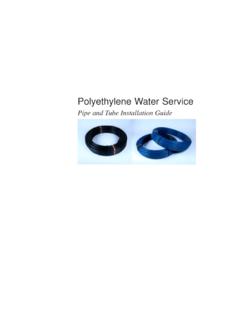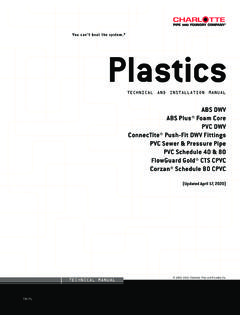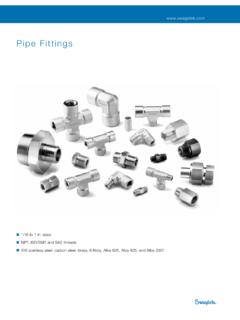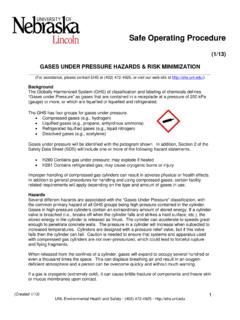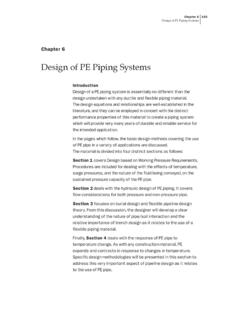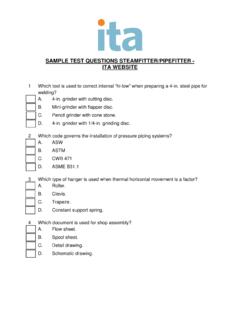Transcription of PRACTICAL PIPING COURSE - Engineer
1 PRACTICAL PIPING COURSE . OUTLINE. 1. Introduction Definition of PIPING 3. PIPING Nomenclature & Components 4. Regulatory Acts, Codes & Standards 6. Line Designation Tables 8. Problem Set 1 9. 2. Codes & Standards ASME 10. NEPA / NFC / NFPA 12. CSA 13. MSS 14. API 15. ASTM 16. Problem Set 2 17. 3. Supplemental Documents Owner's Specifications & Documents 20. Contractor's Standards & Documents 21. Problem Set 3 21. 4. PIPING Design Failure Mechanisms 22. Code Considerations for Design 23. Material Selection 34. Fabricated Tees & Area Reinforcement 44. PIPING Flexibility Analysis 45. 5. References 46. EDA Copyright 2012. Engineering Design & Analysis Ltd PRACTICAL PIPING COURSE Disclaimer ! This short COURSE is not a substitute for accessing and using the Codes directly in conformance to generally accepted engineering practice. Consult the appropriate Codes and references prior to designing and engineering any PIPING systems.
2 In some jurisdictions, a Professional Engineer must design pressure PIPING . EDA Copyright 2012. Engineering Design & Analysis Ltd 2. PRACTICAL PIPING COURSE Introduction Definition of PIPING pipe is a pressure tight cylinder used to convey a fluid or to transmit a fluid pressure , ordinarily designated pipe in applicable material specifications. Materials designated tube or tubing in the specifications are treated as pipe when intended for pressure service. PIPING is an assembly of PIPING components used to convey, distribute, mix, separate, discharge, meter, control or snub fluid flows. PIPING also includes pipe -supporting elements but does not include support structures, such as building frames, bents, foundations, or any equipment excluded from Code definitions. PIPING components are mechanical elements suitable for joining or assembly into pressure -tight fluid containing PIPING systems. Components include pipe , tubing, fittings, flanges, gaskets, bolting, valves and devices such as expansion joints, flexible joints, pressure hoses, traps, strainers, in-line portions of instruments and separators.
3 PIPING is typically round. EDA Copyright 2012. Engineering Design & Analysis Ltd 3. PRACTICAL PIPING COURSE PIPING Nomenclature, Components Graphic of PIPING system illustrating header branch connection valve flange expansion joint expansion loop pipe support reducer elbow EDA Copyright 2012. Engineering Design & Analysis Ltd 4. PRACTICAL PIPING COURSE pipe system essentials: Header Main run of PIPING Take off Branch run Stub in Branch fitting connection made to header by direct attachment of branch . Branch Material added in the vicinity of a branch opening to restore the reinforcement mechanical integrity of the pipe NPS Nominal pipe size pipe support Support elements which serve to maintain the structural integrity of the PIPING system, these are typically non-linear elements Spring support Support provided by an element composed of a spring assembly, these are linear support elements Snubber Support provided by an element composed of a non-linear, damping element Category D Within reference of , a service classification Category M Within reference of , a service classification Expansible Any vapour or gaseous substance, any liquid under such pressure fluid and temperature such that when pressure is reduced to atmospheric, will change to a gas Hydro test Test pressure = x MAWP (some of the time).
4 MAWP Maximum allowable working pressure MDMT Minimum design metal temperature Fracture Typically measured by CVN (Charpy V Number) at MDMT. toughness EDA Copyright 2012. Engineering Design & Analysis Ltd 5. PRACTICAL PIPING COURSE Regulatory Acts, Codes & Standards Codes Codes are rules for the design of prescribed systems which are given the force of law through provincial, state and federal legislation. In Canada, provincial governments have the responsibility for public safety which includes these facilities, among others: pressure PIPING pressure vessels Boilers Pipelines Plumbing systems Gas PIPING Alberta Safety Codes Acts and Codes of Practice The following are applicable to the first four facilities listed above. Boilers and pressure Vessels Regulation Prescribes requirements for registration of pressure vessels, boilers, pressure PIPING and fittings Design, Construction and Installation of Boilers and pressure Vessels Regulations Cites the codes and bodies of rules that form part of the regulations CSA B51 Boiler, pressure Vessel and pressure PIPING Code CSA B52 Mechanical Refrigeration Code CAN/CSA Z184 Gas Pipeline Systems ASME Boiler & pressure Vessel Code ASME B31 pressure PIPING Codes Power PIPING Process PIPING Liquid Transportation Systems for Hydrocarbons, Liquid Petroleum Gas.
5 Anhydrous Ammonia and Alcohols Refrigeration PIPING ANSI Safety Requirements for the Storage and Handling of Anhydrous Ammonia NFPA 58 Standard for the Storage and Handling of Liquefied Petroleum Gases DOT Regulations of the Department of Transportation Governing the Transportation of Hazardous Materials in Tank Motor Vehicles MSS Standard Practice SP 25 Standard Marking System for Valves, Fittings, Flanges and Unions TEMA Standards of Tubular Exchanger Manufacturers Association EDA Copyright 2012. Engineering Design & Analysis Ltd 6. PRACTICAL PIPING COURSE Pipeline Act Cites the minimum requirements for the design, construction, testing, operation, maintenance and repair of pipelines : CSA Z662 Oil and Gas Pipeline Systems CAN/CSA Z183 Oil Pipeline Systems (superceded). CAN/CSA Z184 Gas Pipeline Systems (superceded). CSA Z169 Aluminum pipe and pressure PIPING Systems Canadian Petroleum Association Recommended Practice for Liquid Petroleum Pipeline Leak Prevention and Detection in the Province of Alberta In the US: As in Canada, some facilities are governed by federal regulations.
6 Interstate pipeline facilities are defined by the: Code of Federal Regulations, Title 49. Part 192 Transportation of Natural and Other Gas by Pipeline Minimum Federal Safety Standards Part 193 Liquefied Natural Gas Facilities Part 195 Transportation of Hazardous Liquids by Pipeline Other pipeline pressure PIPING codes include: ASME Pipeline Transportation Systems for Liquid Hydrocarbons and Other Liquids ASME Gas Transmission and Distribution Systems EDA Copyright 2012. Engineering Design & Analysis Ltd 7. PRACTICAL PIPING COURSE Line Designation Tables The Province of Alberta Safety Codes Act "Design, Construction and Installation of Boilers & pressure Vessels Regulations" par 7(2) requires that construction of a pressure PIPING system must include submission of drawings, specifications and other information and include: (a) flow or line diagrams showing the general arrangement of all boilers, pressure vessels, pressure PIPING systems and fittings (b) pipeline identification lists showing the maximum pressures and temperatures for each pressure PIPING system (c) a list of pressure relief devices, including the set pressure (d) material specifications, size, schedule and primary service rating of all pressure PIPING and fittings (e) the welding procedure registration number (f) the pressure pipe test procedure outlining the type, method, test media , test pressure , test temperature, duration and safety precautions (g) a form, provided by the Administrator, completed by the engineering designer or contractor which relates to the general engineering requirements for design and field construction of pressure PIPING systems (h)
7 Such other information as is necessary for a safety codes officer to survey the design and determine whether it is suitable for approval and registration EDA Copyright 2012. Engineering Design & Analysis Ltd 8. PRACTICAL PIPING COURSE Problem Set 1. 1 Which Act governs the design of plant pressure PIPING systems in Alberta? 2 Are process plant water lines considered pressure PIPING systems? 3 For what fluid service category may a hydro test be waived per 4 What is the difference between a pipe elbow and a bend? EDA Copyright 2012. Engineering Design & Analysis Ltd 9. PRACTICAL PIPING COURSE Codes and Standards The following codes are used for the design, construction and inspection of PIPING systems. The ASME B31 PIPING Codes PIPING codes developed by the American Society of Mechanical Engineers: Power PIPING PIPING typically found in electric power generating stations, in industrial and institutional plants, geothermal heating systems and central and district heating and cooling plants.
8 Process PIPING PIPING typically found in petroleum refineries, chemical, pharmaceutical, textile, per, semiconductor and cryogenic plants and related processing plants and terminals. Pipeline Transportation Systems for Liquid Hydrocarbons and Other Liquids PIPING transporting products which are predominately quid between plants and terminals and within terminals, pumping, regulating, and metering stations. Refrigeration PIPING PIPING for refrigerants and secondary coolants. Gas Transportation and Distribution PIPING Systems PIPING transporting products which are predominately gas between sources and terminals including compressor, regulating and metering stations, gas gathering pipelines. Building Services PIPING PIPING typically found in industrial, institutional, commercial and public buildings and in multi-unit residences which does not require the range of sizes, pressures and temperatures covered in Slurry Transportation PIPING Systems PIPING transporting aqueous slurries between plants and terminals within terminals, pumping and regulating stations.
9 EDA Copyright 2012. Engineering Design & Analysis Ltd 10. PRACTICAL PIPING COURSE The following codes are used to specify the geometric, material and strength of PIPING and components: ASME B16 Dimensional Codes The ASME B16 PIPING Component Standards PIPING component standard developed by the American Society of Mechanical Engineers or the American National Standards Institute (ANSI). Cast Iron pipe Flanges and Flanged Fittings Malleable Iron Threaded Fittings, Class 150 and 300. Cast Iron Threaded Fittings, Classes 125 and 250. pipe Flanges and Flanged Fittings Factory Made Wrought Steel Buttwelding Fittings Face to Face and End to End Dimensions of Valves Forged Fittings, Socket Welding and Threaded Cast Iron Threaded Drainage Fittings Ferrous pipe Plugs, Bushings and Locknuts with pipe Threads Cast Bronze Threaded Fittings Class 125 and 250. Cast copper Alloy Solder Joint pressure Fittings Ring Joint Gaskets and Grooves for Steel pipe Flanges Nonmetallic Flat Gaskets for pipe Flanges Wrought copper and copper Alloy Solder Joint pressure Fittings Cast copper Alloy Solder Joint Drainage Fittings DWV.
10 Cast copper Alloy pipe Flanges and Flanged Fittings Class 150, 300, 400,600, 900, 1500 and 2500. Buttwelding Ends Cast copper Alloy Fittings for Flared copper Tubes Wrought Steel Buttwelding Short Radius Elbows and Returns Wrought copper and Wrought copper Alloy Solder Joint Drainage Fittings DWV. Cast copper Alloy Solder Joint Fittings for Sovent Drainage Systems Manually Operated Metallic Gas Valves for Use in Gas PIPING systems Up to 125 psig (sizes through 2). Valves Flanged, Threaded and Welding End Orifice Flanges Hydrostatic Testing of Control Valves Large Metallic Valves for Gas Distribution (Manually Operated, NPS 2 to 12, 125 psig maximum). Malleable Iron Threaded pipe Unions, Classes 1150, 250 and 300. Manually Operated Thermoplastic Gs Shutoffs and Valves in Gas Distribution Systems Ductile Iron pipe Flanges and Flanged Fittings, Class 150 and 300. Large Diameter Steel Flanges (NPS 26 through NPS 60).
